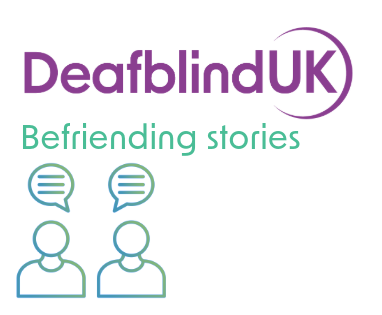How to communicate with a person who is deafblind

Talking with people with sight and hearing loss and including them in conversations is easy. Here are our top tips to help you communicative effectively with a person who is deafblind.
How can people who cannot see or hear communicate?
People who are deafblind have many ways to communicate. Some of the most common ways include:
- British Sign Language (BSL)
- Hands-on signing
- Braille
- Block alphabet
- Clear speech
- Deafblind manual
- Lipreading
- PECs or pictures
- Swell pictures
- Tadoma.
Many people living with combined sight and hearing loss choose to use a combination of communication methods. It depends on the person, their preferences and what works best for them.
How to talk with a person who is deafblind
These are our top tips for communicating and connecting with people who are deafblind.
Ask questions and listen
If you’re not sure what to do, ask the other person what their preferred method of communication is.
Don’t worry if you don’t know sign language or other alternative forms of communication. It’s much better to ask politely about what you can do to make communicating easier, than to miss out.
Think about the space you’re in
Whether you’re at home or out, our spaces tend to have background noises and visual clutter that can make it harder for people who have sensory loss to communicate. Here are some small things you can do to keep your space accessible:
- Reduce background noise – turn off your music or radio
- Change the lighting – ask what sort of lighting is best for the other person
- Tidy up clutter or move very visually distracting objects – turn off the TV.
Use clear speech
One method people with sight and hearing loss may use to communicate is clear speech. Speaking clearly is a very effective and easy way of communicating with someone who is deafblind.
Introduce yourself
A person who is deafblind might not recognise your face or voice so well. It can be helpful to introduce yourself clearly when you join a conversation with them. This way they know exactly who they’re speaking with.
Get their attention
Someone with sight and hearing loss might not know when you’re trying to get their attention. If you need to get their attention:
- Try making a noise or vibration, such as knocking on a table
- Make eye contact with the other person
- If you know the person and they are comfortable with it, you could lightly touch their shoulder and let them know it’s you.
Keep your mouth visible
Some people who are deafblind use lipreading to communicate. Lipreading relies on being able to see a person’s mouth, lip shape and facial expressions while they speak. If you’re speaking with a person who prefers to lipread:
- Use a face mask that has a clear insert so they can still see your mouth
- Face the other person directly
- If possible, remove anything that might get in the way of their view of your lips and face.
Speak with the person, not their companion
Some people who are deafblind might have an interpreter or guide with them. If you’re having a conversation with them, address them as you usually would and don’t focus on their companion. Not only is this the polite thing to do but facing the person who is deafblind and speaking directly with them can help them communicate better with you.
Let’s keep in touch!
Join our mailing list and we will keep you up to date about our projects and opportunities to get involved with Deafblind UK.
More Articles

Ian’s fundraising ‘snookerthon’ in memory of his mum who was deafblind
Remember how we always talk about getting creative with fundraising and doing it your own way? Well, meet Ian Pettey,…

School Liaison Officer Carolyn tells us about Lesson in a Box
“Ensuring that all students have a positive experience of education is vital to ensuring that everyone becomes a valuable member…


